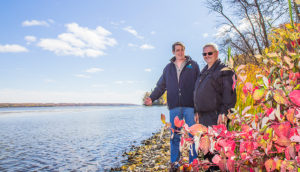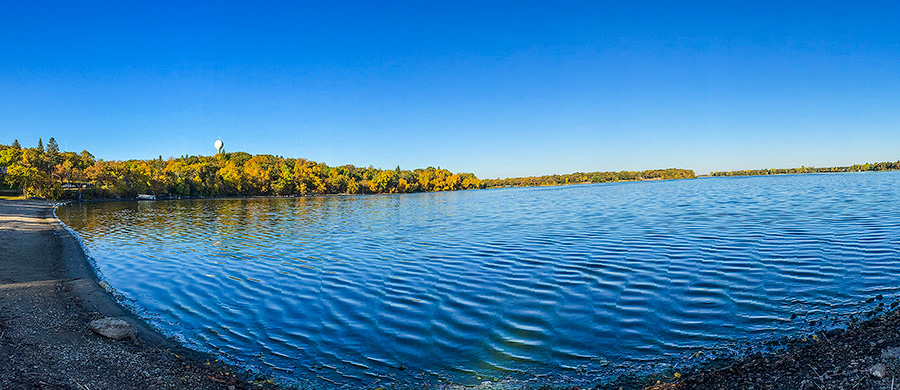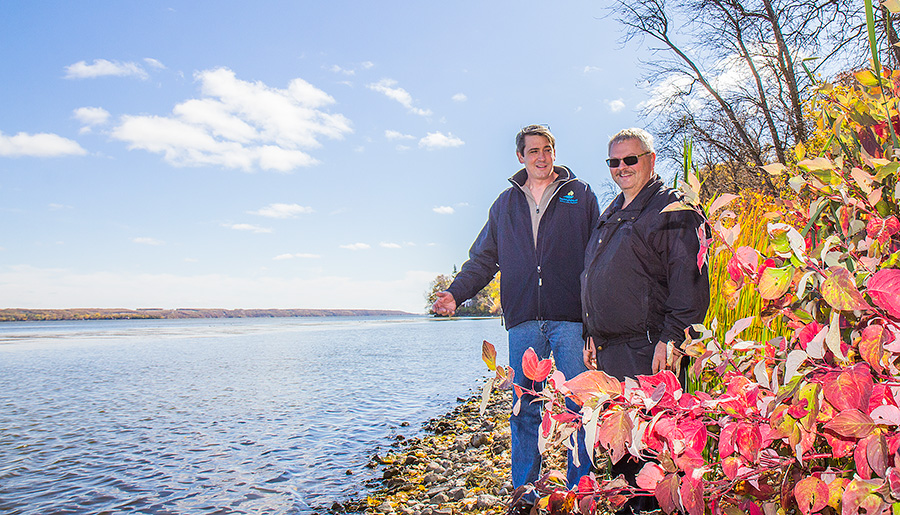
Mavericks claim aeration is defeating algae
BY KIM LANGEN
Could the introduction of fresh air into lake water become the genie in the bottle for Killarney Lake?
For two maverick guys on Ninette’s Pelican Lake Healthy Lake Committee, it’s a no brainer.
Trevor Maguire and Gerry Paradis, who got together about five years ago to try oxygenation on for size, say that their efforts to aerate the murky Pelican Lake have achieved astounding results.
“Pelican Lake was a slough,” said Maguire, a business advisor with a couple years of geology study behind him. “Every five to seven years we would have a massive fish die-off. And that was my reason to try and change things. We wanted to stop the die-off. The ice would go out in the spring, and the fish would be dead on the shore. Thousands of them – perch, jack, walleye, carp, suckers – the entire population. These dead fish were trucked away, and used as fertilizer on farmers’ fields. Our last one was in 2003/2004, and we should have had a die-off a few years ago. But we didn’t.”
Plumber Gerry Paradis, who operates Paradise Geothermal, harboured the same goal.
“I met Trevor in 2012, and the idea of aerating the lake sounded very promising,” he said. “So I got on board. I think we are on the right track, and things are working.”
Maguire put his skills as a scuba diver alongside Paradis’ knack with water, wrenches, and pipes, and together with volunteers, they installed a pump station next to the Pelican Lake Yacht Club in 2012/2013.
The two men are members of The Pelican Lake Healthy Water and Fish Committee, a.k.a. The Healthy Lake Committee, which was created in 2012.
The organization promotes water stewardship and fish habitat maintenance, and implements projects and activities to improve the water quality and overall health of Pelican Lake, and its watershed.
Pelican Lake is a 7,000-acre body of water, and averages 10 feet in depth.
The committee’s website states that in recent years the lake has suffered blue green cyanobacteria algal blooms. This algae blooms when there are high levels of nutrients, combined with warm weather, and it is not a food source for fish.
So it dies and decomposes, taking up available oxygen in the lake water. This leads to slow, anaerobic breakdown of organic materials, and the accumulation of a thick layer of muck and detritus that builds up in the bottom of the lake.
Plus it can smell like rotten eggs.
Maguire had heard that in both Alberta and in the American south some communities were using a technique that involved bubbling aeration from below the surface of the water, in order to both percolate oxygen into depleted water bodies and gently stir the water around.
If it was working for them, why not try the system in Pelican Lake, he wondered.
So, along with Paradis, he forged ahead with a plan to breathe life into Pelican Lake.
“We made the choice that we would give it a go,” said Maguire. “We consulted with professionals, and did a lot of our own research, and we decided to use a micro-bubbler aeration system. It consists of many individual bubbler heads that sit on the bottom of the lake, and are connected to an on-shore air supply. These heads produce micro bubbles that resemble soda fizz. The tiny bubbles create more traction, therefore more surface area, and that way they drag water upwards, and they also allow oxygen to mix more easily.”
The team built a small pump house on the shore near the Yacht Club in Ninette to supply the air pressure to their system, and laid a line out into the lake, 15 to 20 feet below ground, to carry the air to the ‘bubbler heads,’ he said.
These bubbler heads, curved around into the shape of a figure eight, resemble short lengths of very hard drip irrigation hoses. And like a drip hose, they allow multiple, tiny amounts of pumped air to exit via their semi-permeable membrane.
“What we are doing is rotating the water column, and bringing up cooler, stratified water from below, and accelerating the breakdown of organic material on the bottom of the lake,” said Maguire. “We are not totally stirring up the effluent at the bottom of the lake; we are circulating the water by it.”
So how do they know that the aeration is making a difference in Pelican Lake, besides reports from dozens who live around and use the lake?
Maguire says he found the answer some time later, whilst down on his knees.
“I went down there in scuba gear, around one of the aerators,” he said. “I couldn’t see anything, because of the turbidity of the water. So I was on my knees. And underneath I felt rocks, and clams – we hadn’t seen clams for years – and hard ground, instead of the usual rotting vegetation at the bottom. It had created a little oasis of life around the aerator, going out around 15 or 20 feet.”
Since the project began, the committee has watched other new life take hold in the lake.
“We have seen armies of crayfish, or ‘crawdads,’ and we now have cormorants,” said Maguire. “The ducks are nibbling in the water around the aerators, finding food. The clams are back, and the people are coming back to the lake. They’re telling me that they are catching two and three fish off the docks. It used to be that by the end of June, and July, the lake would be shut down because of algae.”
This empirical evidence is heartening, said the pair.
But they added that it only works if the aerators run non-stop.
“Once you start aeration, you can’t stop,” said Maguire. “The area will just die again. We use insulated pumps, and the compressors will re-start automatically, because we use a VFD (variable frequency drive) to keep them going, even if there is a power outage.”
Maguire says that elevated phosphate levels in the lake water are what drives the lake to produce the algal blooms – the same way it happens in Killarney Lake.
“Phosphates are 100 per cent responsible,” he said. “We have two to three parts per million of phosphate in the lake, and .5 ppm will bring in an algal bloom. Phosphates come from a variety of sources into Pelican Lake, through runoff. They come from rotting vegetation, from soil, and from fertilizer. There just aren’t the places to ‘store’ water anymore, such as in sloughs. We can’t do much about that now. But we can affect the breakdown of the blue green algae by pumping up the oxygen level in the lake, and (therefore) allowing other things to grow.”
The group monitored the oxygen levels in the months following the installation of the aerators, and say it increased significantly within 800 feet of the aeration.
Today, around 26 micro-bubblers are in operation in the northern basin of Pelican Lake, with nearly 100 other ones installed near Marina Terrace in 2015.
The only sign of the quiet action below the water level is a mild bubbling of water on the surface, visible on a still day.
The committee now uses a donated modified pontoon boat, The Minnow, to lay down lines and install their aeration, which is much easier on the guys who do the work.
“We argue about who gets to be the Skipper,” said Maguire. “The Minnow makes it a lot easier to get the job done.”
The Pelican Lake aeration projects are achieved through support by the Federal Recreational Fisheries Conservation Partnerships Programs Grant, through local fundraising (including the Pelican Lake Fishing Derby), through R.M.s, and a lot of volunteer labour, said the committee.
For Maguire and Paradis, it’s been confirmation about what actually made a difference – rather than hearing from the experts that no perfect solution exists for controlling the spectre of algae in lakes.
They wanted to get the ball rolling, even without study evidence to back it, to see how it played out.
And now, with improved water quality in their beautiful lake, a study might well show that they were on the right track using aeration.
“We just cleaned up our lake,” said Maguire. “It’s cleaner than it was. We are not here to change the world, just the lake. We do want to create a body of data and research to prove it, maybe through a pilot project next summer. We made a lot of mistakes as we went along. If a similar project went ahead at Killarney Lake, where they also have problems with blue-green algal blooms, we would act as advisors, and try to help them avoid the same pitfalls.”

AERATION NEXT FOR KILLARNEY LAKE? – The Killarney Lake Action Committee (KLAC) hopes to have an aeration project in place for 2018. With the success of the Pelican Lake project, and after consultation with Trevor Maguire, Gerry Paradis and other members of the Ninette committee, the KLAC is forging ahead with plans of their own to aerate Killarney Lake. Local contractors and Manitoba Hydro employees have offered their help and expertise, and Killarney-Turtle Mountain Council has offered their moral support for the project. Stay tuned to The Guide for more aerating updates.

IMPROVING LAKE QUALITY – Trevor Maguire (left) and Gerry Paradis (right), members of the Pelican Lake Healthy Water and Fish Committee, led the charge as they waded in with a new idea to clean up the lake water. The pair started a project five years ago, using aeration to improve the water quality and reduce algae in Pelican Lake, and it seems to be working.

BUBBLER HEADS – Trevor Maguire holds up one of the bubbler heads, a figure eight-shaped section of semi permeable hose, which allows tiny bubbles to percolate up through several feet of lake water. The air, driven through a pump on shore, adds oxygen to the water, and also helps move the water around gently, speeding up the decomposition of organic matter.

